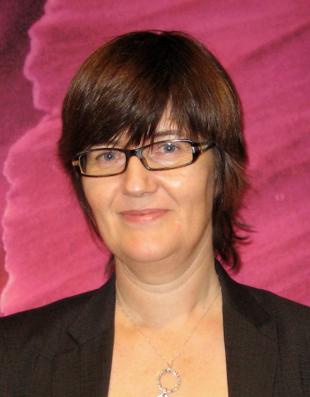“The worst episode was when I was sitting in the living room on a spindle back chair reading the newspaper. The children were there. Then she said to me that I had to do the dishes right away. Then I said I was just going to finish reading the newspaper first. And then she came into the living room and grabbed my hair and pulled me backwards so that I fell on the floor, and she sat on top of me and hit me in the face. The children were watching and started to cry.”
This is a statement from one of the 10 men interviewed by Tove Ingebjørg Fjell about their life with a violent intimate partner. Fjell, a professor of cultural studies at the University of Bergen, participated in the conference Historier som ikke finnes (“Stories that never happened”) held in Oslo in November. The event focused on violence against men in intimate relationships. Fjell gave a presentation on her research project Å gå på nåler hele tiden (“Always walking on eggshells”), which she plans to complete this spring.
Difficult start
“It was extremely difficult to find someone who would talk to me. Many of the men were afraid. They feared that their wives would find out and do something, like leave with the children. When they first came to the interview, they talked incessantly, in a positive sense. I almost didn’t need to ask any questions at all. The stories just poured out of them,” says Fjell.
“The men’s stories about violence by their partners show how important it is to downplay the focus on the gender dimension that we have today. We have a biased view of the man as the perpetrator on the one hand and the woman as the victim on the other. We need to understand that violence involves human beings,” says Fjell.
Great similarities
“I don’t remember the first time. It’s a little strange. It’s as if you lived in a place where it was very dangerous to walk in the streets and every day someone came and beat you up. But you survived and it became a part of your daily life. You go and buy vegetables at the store, but you don’t remember what vegetables you used and bought two years ago. It’s like that with violence too. You just accept it and hope that it passes.”
This is how one of the men Fjell spoke with described the experience of being the victim of violence. It is a common, gender-neutral description. This similarity between men’s and women’s stories about intimate partner violence is one of the main findings in Fjell’s study.
“Men’s stories are reminiscent of what we read in the traditional literature on wife abuse. Men are also beaten, hit on the head with an ashtray or threatened with a knife by their partners. Most of them tell about episodes of psychological violence, such as a wife calling on the phone constantly to control what her husband is doing. Or the partner makes threats. She might threaten to file for divorce if her husband has contact with his family. Some women threaten to murder the children,” says Fjell.
Common features of men’s stories
During the interviews Fjell found some common features that she believes are typical for men who are victims of intimate partner violence.
“There’s something about the way men tell their stories. I would call it understatement. Men are able to give concrete descriptions of violent situations, but they don’t call it violence. They often say that they could have thrown her to the ground; they just didn’t do it,” says Fjell, who puts this tendency in the men’s stories in a historical perspective:

“The concept of violence is changing all the time. If the men had told the same stories 60 or 40 years ago, it would not have been called violence, but today we recognize it as violence. Quite simply, it takes time to acquire a language that describes the same action in the same way for men and women,” says Fjell.
“In addition, the men I interviewed have fewer stories of gross violence than we find from female victims of violence. They also have less fear of being killed. Men might be afraid of being seriously injured, but they are not afraid of being murdered by their partners, like some women are,” explains Fjell.
See also: Male victims of women's violence fear not being believed
Men at crisis centres
A common feature of the men Fjell interviewed was that they were very reluctant to seek out help. None of them had contacted a crisis centre, but they did not necessarily rule out the possibility. One of the men put it this way:
“If I had had someone to turn to, who I could go to anonymously, who wasn’t friends with both me and my partner or who didn’t have contact with both of us in another way, then I think I would have gone there. It should probably be a gender-neutral centre because I think very many women who are abused would benefit from seeing that it is not just women who get hit. We could help each other.”
One of the few people knowledgeable about crisis centres in Norway is Wenche Jonassen. A sociologist and researcher at the Norwegian Centre for Violence and Traumatic Stress Studies (NKVTS), she has been studying how crisis centres are run for many years. At the conference she gave a brief presentation on the situation in the wake of the new Norwegian legislation on crisis centres, which in 2010 required all municipalities to provide the same services to men and women.
“I must admit that I reacted with scepticism when I heard about the new crisis centre legislation for the first time. I thought that men could certainly have a need for counselling and advice, but protected overnight accommodation? At that time I could only imagine female partners. It turns out that just as many men who use the overnight accommodation at the crisis centres are the victims of violence by male partners, and yes, they do need the crisis centre services,” says Jonassen.
Pilot study
This spring Jonassen decided to conduct a pilot study to learn about the experiences of the crisis centres after they had been offering their services to men for a period of time. She phoned the eight largest crisis centres in Norway and performed an informal survey.
“The survey showed that of the eight centres I contacted, only five of them had managed to put in place the same services for men that they had for women. Of these, three centres had had men living there,” says Jonassen, who found that there were a variety of reasons that the men contacted the centres.
“Several of the men came because they were being forced into arranged marriage. Other reasons were psychological harassment by women or by homosexual spouses. In addition, ethnic minority men sought out the crisis centre due to cultural conflicts with their families. The survey showed that fewer men than women sought out the crisis centres due to physical violence,” says Jonassen.
Like Fjell, Jonassen concluded that there are great similarities between men and women who are victims of violence.

“The employees of the crisis centres have a great deal of knowledge about female victims of violence. The experiences thus far show that the circumstances surrounding violence are similar enough that this knowledge is also entirely applicable to men who are victims of violence in intimate relationships. But some additional challenges have arisen since men are now using the crisis centres. Some examples of this are homosexual tendencies in men and some cultural conflicts. Young, ethnic minority men have used the overnight accommodation due to their families’ reaction to what is viewed as unacceptable behaviour. This might be that the son in the home has socialized with people from other cultural groups or that he does not practice his religion,” says Jonassen.
Shame and invisibility
“I sat there with bruises on my face from the beating and didn’t dare say anything about it and...then she told me that it wasn’t really so bad. There were other things she didn’t believe me about. She said straight out that she didn’t believe me. That was the worst thing of all.”
This statement was made by one of Fjell’s informants. He was disappointed that when he told his regular therapist about the violence he experienced at home, she responded by mistrusting him and downplaying his experience. Many of the men Fjell interviewed refrained from telling others about the violence because they were afraid of not being believed. Shame was also part of the picture.
“Men help to keep their stories a secret by not talking about them. And the public system of services helps to maintain this secrecy by not acknowledging that men can be victims of violence. These two groups actually work together to keep the stories from coming to light. The title of this conference on violence against men is illustrative of this: Stories that never happened. But these stories do happen. The question is whether there is sufficient interest in the problem within the health service. There are very few places where we can acquire knowledge about male victims of violence and insufficient language for capturing what they experience. As a result, men often believe they are completely alone with their experiences. Many years can pass before they develop an awareness of what they have been subjected to,” says Fjell, who would like to see a discussion that brings violence against men out into the open.
“Initially we need the same kind of discussion we had in the 1970s when violence against women was in focus. We don’t need to spend 30 years discussing intimate partner violence against men, but it will be necessary to spend some time and resources in order to shed sufficient light on this topic,” says Fjell.
Much work remains
Studies of male victims of intimate partner violence are relatively new in Norway, and both Fjell and Jonassen emphasize that most of the work still remains.
“Men now have access to crisis centres in Norway for the first time ever. It is important to find out what they are struggling with, what type of services they are seeking and what the differences are between men and women in this area,” says Jonassen. She wants to conduct a study on this in the near future.
“Most of the men in my study are in their forties, but violence has no age limit. Studies can be done that address the entire generational spectrum, including older women and their use of violence. What kind of numbers are we are talking about in these cases? We know very little about this today,” says Fjell.
Translated by Connie Stultz.
Tove Ingebjørg Fjell is a professor at the Department of Archaeology, History, Cultural Studies and Religion at the University of Bergen.
Wenche Jonassen is a researcher at the Norwegian Centre for Violence and Traumatic Stress Studies (NKVTS).



